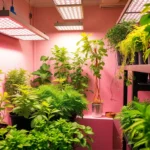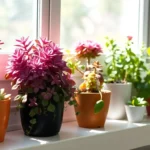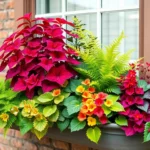We’ve all stood in our bathrooms wishing they felt more like a spa than a sterile space. The good news? Adding plants to your bathroom can transform this utilitarian room into a lush retreat that rivals any high-end wellness center.
Bathrooms offer unique growing conditions that many plants absolutely love – high humidity, warm temperatures, and often filtered light. These aren’t obstacles to overcome but advantages to embrace. The right plants don’t just survive in bathroom environments; they thrive and create a stunning visual impact.
Whether you’re dealing with a windowless powder room or a bright master bath, we’ll show you how to select and care for bathroom plants that flourish in your exact space. From low-maintenance options for beginners to show-stopping specimens for experienced plant parents, there’s a perfect green addition waiting to elevate your bathroom’s ambiance.
Benefits of Adding Plants in the Bathroom
Plants can completely transform your bathroom experience while providing many practical advantages. We’ve identified three key benefits that make bathroom plants an excellent investment for any home.
Improved Air Quality and Humidity Control
Plants naturally purify the air by absorbing harmful toxins and releasing clean oxygen throughout your bathroom space. We recommend spider plants, Boston ferns, and snake plants as they remove formaldehyde, benzene, and other common household pollutants found in cleaning products and building materials.
Bathroom plants help regulate humidity levels by absorbing excess moisture from the air during hot showers and baths. This natural humidity control prevents mold growth and reduces condensation on mirrors and windows. Air purifying plants like peace lilies and pothos work particularly well in bathrooms because they thrive in high humidity environments while actively filtering indoor air pollutants.
Research shows that certain bathroom plants can remove up to 87% of air toxins within 24 hours. Plants like aloe vera and English ivy excel at absorbing volatile organic compounds commonly found in personal care products and synthetic materials.
Natural Stress Relief and Spa-Like Ambiance
Plants create an immediate calming effect that transforms your bathroom into a personal wellness retreat. We notice that green foliage naturally reduces cortisol levels and promotes relaxation during daily routines like morning preparations and evening wind-down rituals.
Bathroom plants provide biophilic benefits that connect us with nature even in indoor spaces. Studies indicate that simply viewing plants for 3-5 minutes can lower blood pressure and reduce anxiety levels. Popular choices like bamboo, monstera, and rubber trees add tropical resort vibes that make ordinary bathroom visits feel like mini spa experiences.
Natural textures and colors from plants soften harsh bathroom surfaces like tiles, glass, and metal fixtures. This organic contrast creates visual warmth that makes the space feel more inviting and peaceful.
Enhanced Aesthetic Appeal and Visual Interest
Plants add ever-changing visual layers that break up monotonous bathroom color schemes and create focal points throughout the space. We suggest using trailing plants like pothos or string of hearts to add vertical interest from shelves or hanging planters.
Bathroom plants provide year-round greenery that never goes out of style, unlike seasonal decorations or trendy accessories. Living plants create texture variety that complements both modern minimalist designs and traditional bathroom aesthetics. Popular plant combinations include tall floor plants like fiddle leaf figs paired with smaller countertop succulents for balanced visual composition.
Strategic plant placement draws attention to exact bathroom features like vanity areas, bathtub corners, or window sills. Plants also help camouflage less attractive elements like plumbing fixtures or storage areas while highlighting your bathroom’s best architectural features.
Best Low-Light Plants in the Bathroom for Beginners
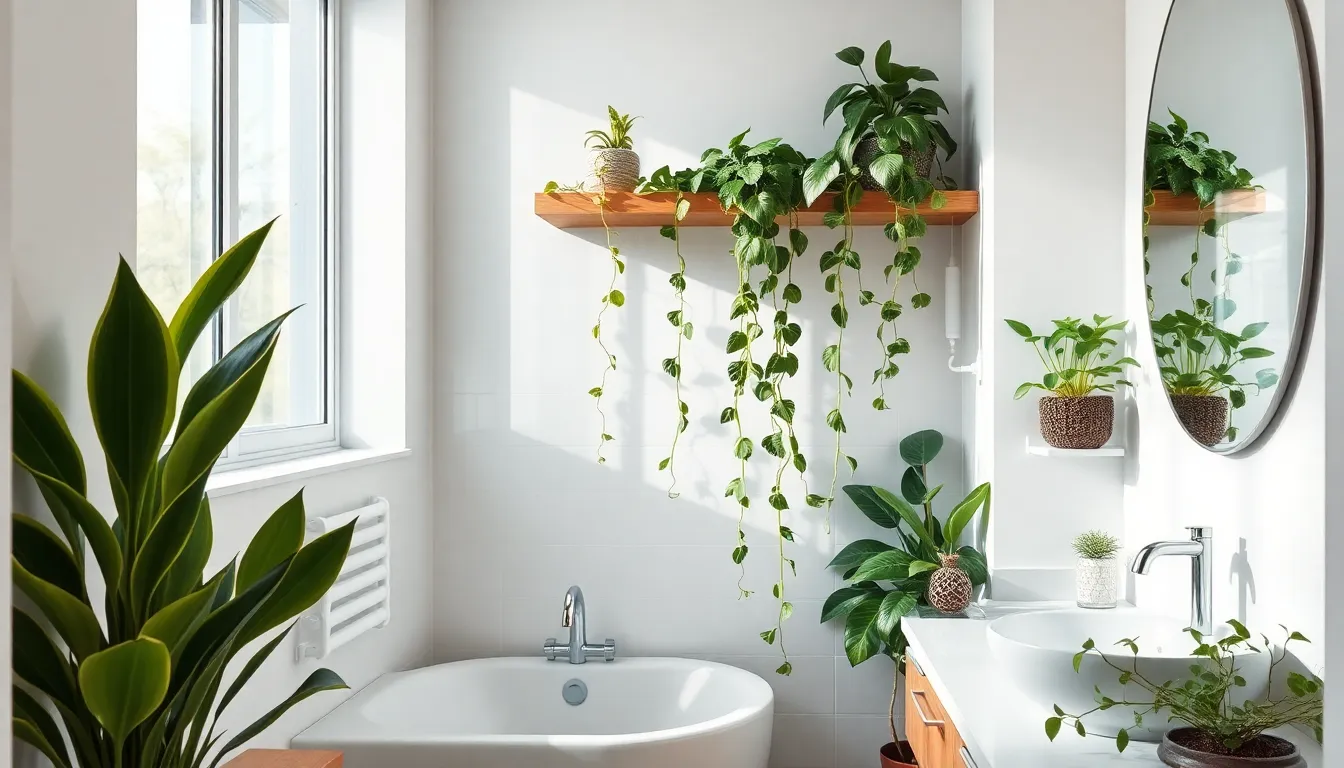
Selecting the right plants for your bathroom’s unique environment becomes effortless when you focus on these three exceptional varieties. We’ve identified the most resilient options that thrive in low light conditions while requiring minimal maintenance.
Snake Plants for Ultimate Durability
Snake plants stand as the ultimate choice for bathroom beginners who want guaranteed success. These hardy specimens tolerate irregular watering schedules and flourish in the dim lighting that characterizes most bathrooms. We recommend snake plants because they’re virtually indestructible, making them perfect for first-time plant parents who may forget occasional care routines.
Their upright, sword-like leaves create striking vertical interest while fitting perfectly into tight bathroom corners. Snake plants actually prefer the humid environment your bathroom naturally provides, eliminating the need for additional misting or humidity adjustments. You’ll find these plants continue growing steadily even when placed far from windows or natural light sources.
Pothos for Easy Propagation
Pothos plants offer beginners an exciting opportunity to expand their bathroom garden through simple propagation methods. These trailing beauties thrive in low light conditions while embracing the naturally humid bathroom atmosphere. We love how pothos plants multiply effortlessly when you place cuttings in water, allowing you to create multiple plants from a single purchase.
Their cascading vines add soft, flowing texture that beautifully contrasts with hard bathroom surfaces like tile and porcelain. Pothos plants adapt remarkably well to various lighting conditions, from bright indirect light near windows to dimmer corners where other plants might struggle. You can train these versatile plants to climb bathroom walls or let them drape elegantly from shelves and hanging baskets.
ZZ Plants for Minimal Maintenance
ZZ plants excel as the ultimate low-maintenance bathroom companions for busy beginners. These remarkable specimens tolerate extended periods between waterings while maintaining their glossy, attractive appearance in low light conditions. We appreciate how ZZ plants remain resilient to neglect, making them ideal for bathrooms that don’t receive consistent daily attention.
Their thick, waxy leaves naturally resist the humid conditions that might damage other houseplants. ZZ plants require watering only when their soil becomes completely dry, which typically occurs every 2-3 weeks in bathroom environments. You’ll discover these plants actually prefer the stable temperatures and humidity levels that bathrooms naturally maintain throughout the year.
Humidity-Loving Plants in the Bathroom That Thrive
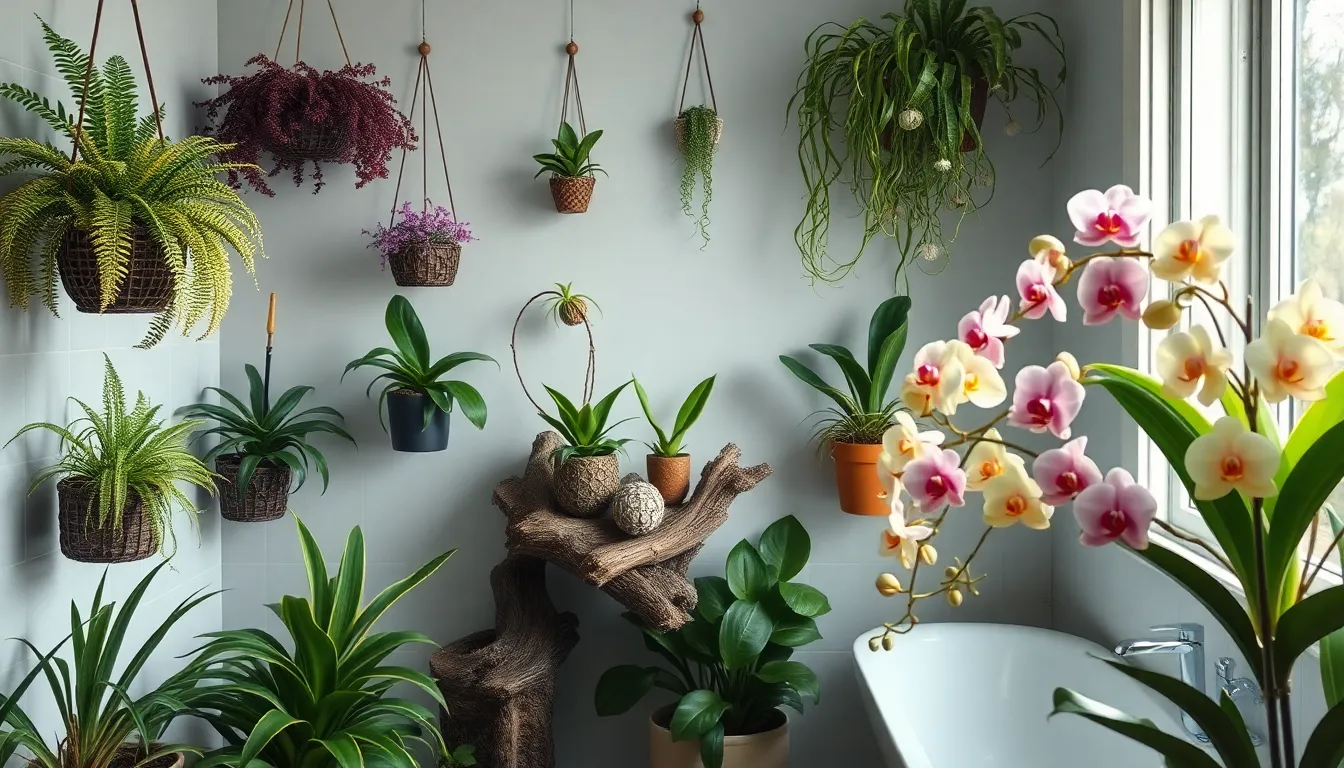
We’ve covered beginner-friendly low light options, but some plants absolutely flourish when they can take full advantage of your bathroom’s naturally humid environment. These moisture-loving species transform your space into a lush retreat while thriving in conditions that challenge other houseplants.
Boston Ferns for Lush Green Texture
Boston Ferns create stunning focal points with their feathery, bright green fronds that cascade beautifully from shelves or hanging baskets. These classic plants prefer the moist air that bathrooms naturally provide, mimicking their native tropical environments perfectly. We recommend placing them near windows with indirect light, as direct sunlight can scorch their delicate foliage.
Maintaining Boston Ferns requires consistent moisture without waterlogged soil conditions. Their soil should stay moist but never soggy, and the high humidity from your daily showers provides the perfect growing environment. Regular watering combined with your bathroom’s natural moisture creates ideal conditions for these lush beauties to flourish year round.
Air Plants for Unique Display Options
Air Plants offer incredible versatility since they don’t require soil and absorb moisture directly from the surrounding air. These fascinating Tillandsia species can be mounted on driftwood, displayed in glass terrariums, or arranged in hanging clusters for dramatic visual impact. We love how they adapt to creative bathroom displays that traditional potted plants simply can’t achieve.
Caring for Air Plants in bathrooms involves providing bright, indirect light and occasional soaking or misting sessions. The steam from your showers provides much of their needed moisture, though weekly soaking helps ensure optimal health. Their unique growing habits make them perfect conversation pieces while requiring minimal maintenance from busy homeowners.
Orchids for Elegant Flowering Beauty
Orchids bring sophisticated elegance to bathroom spaces with their long-lasting, stunning blooms that brighten even the most neutral color schemes. Tropical varieties like Phalaenopsis particularly appreciate the warmth and consistent humidity that bathroom environments provide naturally. We find they create an instant spa-like atmosphere that transforms ordinary bathrooms into luxurious retreats.
These flowering beauties require indirect light and benefit tremendously from the moisture produced during showers and baths. Good air circulation around their roots prevents rot while regular watering and occasional fertilizing encourages repeat blooming cycles. The combination of bathroom humidity and proper care results in healthy plants that reward us with months of beautiful flowers.
Strategic Placement Ideas for Plants in the Bathroom

Now that we’ve covered the best plant varieties for humid conditions, let’s explore where to position them for optimal growth and visual appeal.
Window Sill Arrangements for Natural Light
Window sills offer the perfect spot for plants that benefit from natural light in your bathroom space. Popular plants like ferns and orchids flourish in these locations because bathrooms provide the filtered light and humidity these species prefer. We recommend arranging multiple plants of varying heights along your window sill to create visual interest without blocking natural light.
This placement strategy doesn’t consume valuable floor space while visually connecting your indoor greenery with the outdoor industry. Spider plants and pothos work exceptionally well on window sills since they can trail gracefully while soaking up the available sunlight. Position taller plants toward the back and shorter ones in front to ensure each plant receives adequate light exposure.
Hanging Plant Answers for Small Spaces
Hanging plants maximize vertical space in bathrooms where surface area is limited. We suggest suspending planters from ceiling hooks or shower rails, grouping two or three at varying heights for a layered effect that draws the eye upward. Materials like rattan or brass planters add texture and subtle luxury to your bathroom design.
Spider plants excel in hanging arrangements due to their low maintenance requirements and striking appearance with long, cascading leaves. Proper drainage is crucial for hanging plants, so we recommend using lined planters with plastic pots featuring drainage holes inside. Adding a layer of stones beneath the plant prevents waterlogging while maintaining the humid environment your plants need.
Hanging arrangements keep counters clutter free while adding vibrant greenery at eye level or above your daily routines. This placement option works particularly well above bathtubs or in shower corners where plants won’t be directly hit by water spray.
Corner Plant Displays for Maximum Impact
Corners represent underutilized spaces that transform dramatically with strategic plant displays. Grouping different species on corner shelves or placing tall plants like dragon plants and snake plants creates depth and enhances your bathroom’s natural decor. Ferns work exceptionally well in corner arrangements since they can be floor potted, shelf mounted, or even suspended above shower areas.
We recommend creating height variation by combining floor plants with elevated specimens on floating shelves or plant stands. This approach maximizes visual impact while ensuring each plant receives appropriate light and air circulation. Snake plants and ZZ plants thrive in corner positions since they tolerate lower light conditions common in these areas.
Mirrors positioned behind corner plant setups reflect greenery and light, making your bathroom feel larger and brighter while benefiting plant growth. This combination of strategic placement and reflective surfaces creates a lush, spa like atmosphere that transforms your daily routines into refreshing experiences.
Essential Care Tips for Plants in the Bathroom Environment
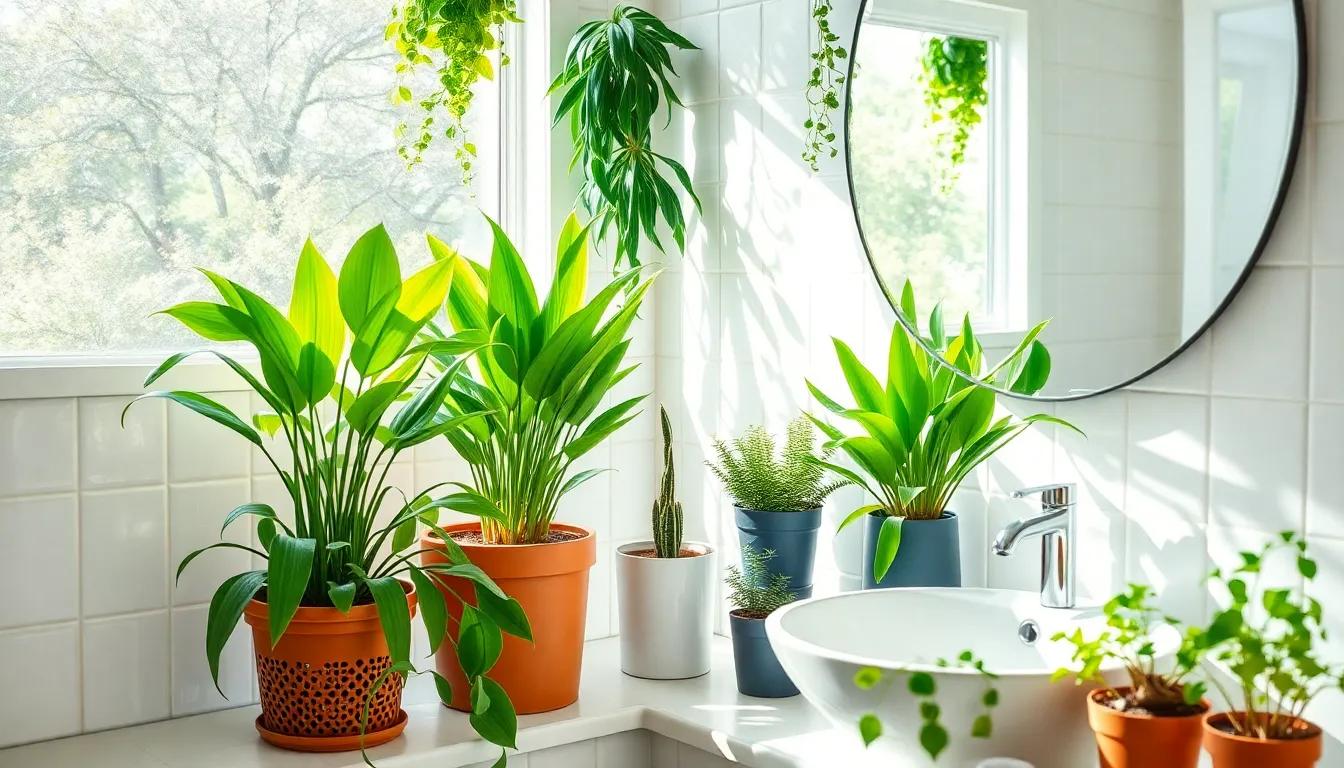
Now that we’ve covered plant selection and placement, let’s jump into the exact care requirements that’ll keep your bathroom plants thriving in this unique environment.
Watering Guidelines for High-Humidity Spaces
Adjust your watering schedule to account for the naturally moist bathroom environment. We’ve found that most bathroom plants need watering 25-30% less frequently than they would in other rooms because humidity from showers and baths provides consistent moisture.
Check soil moisture levels by inserting your finger about an inch deep into the potting mix. For humidity loving plants like Spiderwort and Anthurium, we recommend keeping soil consistently moist but never soggy throughout their growing season.
Reduce watering frequency during winter months when most tropical plants enter dormancy. During this period, allow the soil surface to dry slightly between waterings to prevent root rot.
Ensure proper drainage by selecting pots with drainage holes and placing saucers underneath to catch excess water. We always remove standing water from saucers within 30 minutes to prevent waterlogged roots.
Lighting Answers for Windowless Bathrooms
Choose low light tolerant varieties like ZZ Plants and Spiderwort when your bathroom lacks natural lighting. These resilient species can survive and even flourish in artificial light conditions without compromising their health.
Install LED grow lights positioned 12-18 inches above your plants if your bathroom has no windows. We recommend full spectrum LED bulbs that provide 2000-3000 lumens for optimal plant growth in completely artificial environments.
Maximize existing light sources by placing reflective surfaces like mirrors behind plant displays to bounce available light throughout the space. This technique can increase light exposure by up to 40% in dimly lit bathrooms.
Position plants strategically near any available light sources, including skylights or frosted windows that provide indirect illumination. Palms, fiddle leaf figs, and prayer plants thrive in these bright, indirect lighting conditions.
Preventing Mold and Fungal Issues
Maintain proper air circulation by opening bathroom doors after showers or installing exhaust fans to reduce stagnant moisture. We’ve observed that good airflow prevents fungal spores from settling on plant leaves and soil surfaces.
Monitor humidity levels using a digital hygrometer, especially if you’re growing succulents or cacti in your bathroom. These desert plants require humidity below 60% to avoid developing fungal diseases that can quickly spread.
Inspect plants weekly for early signs of mold or fungus, including white powdery substances on leaves or fuzzy growth on soil surfaces. Remove affected leaves immediately and improve ventilation to prevent further spread.
Space plants appropriately to allow air movement between foliage and prevent overcrowding that creates pockets of stagnant, humid air. We recommend leaving at least 6 inches between plants to promote healthy air circulation.
Common Mistakes to Avoid With Plants in the Bathroom
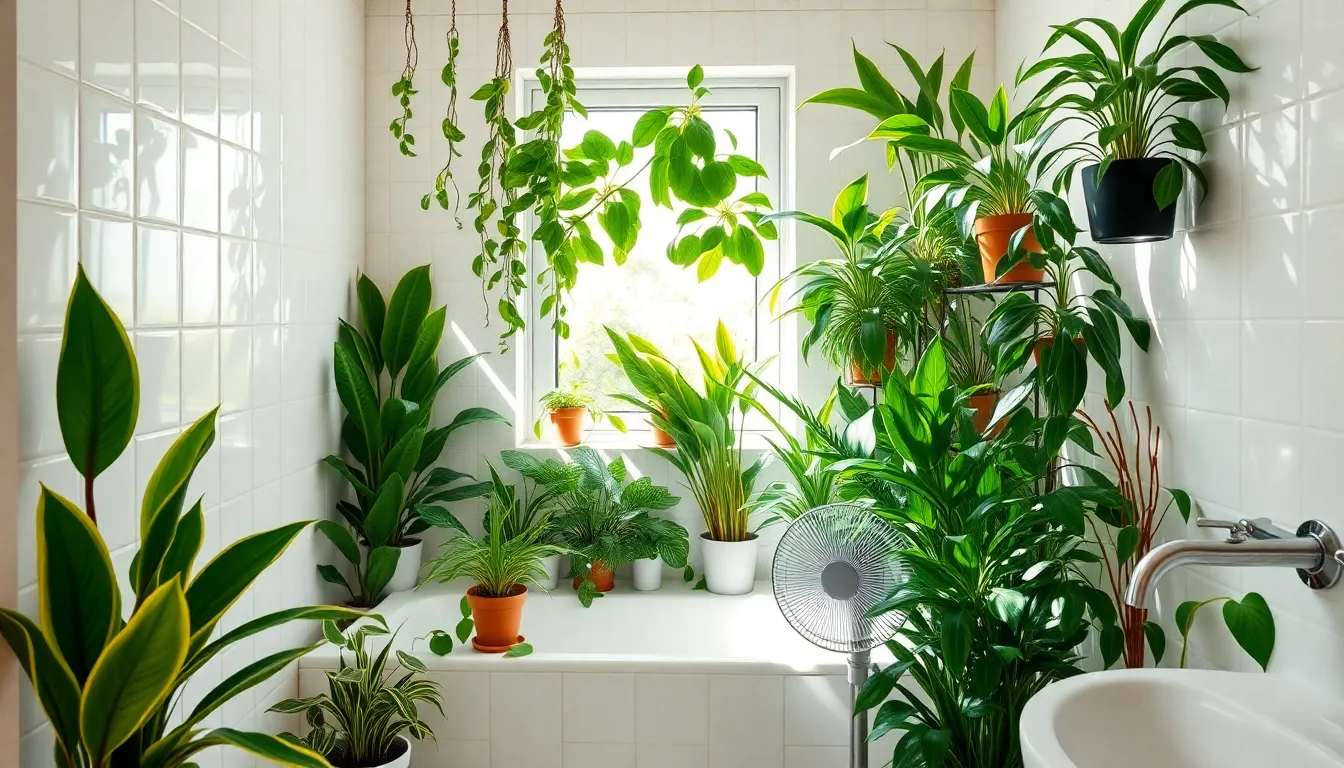
Even though bathrooms provide ideal growing conditions for many plants, several common mistakes can turn your green oasis into a plant care disaster. Let’s explore the most frequent pitfalls that can harm your bathroom plants and learn how to avoid them.
Overwatering Due to Increased Humidity
Overwatering becomes the number one killer of bathroom plants because we often forget that high humidity reduces how frequently our plants need water. Bathrooms typically maintain higher moisture levels than other rooms, which means your plants absorb water from the air as well as through their roots. This extra humidity can cause “wet feet” where roots sit in soggy soil, leading to root rot and plant death.
Smart watering practices prevent this common mistake by using pots with proper drainage holes and allowing soil to dry between watering sessions. We recommend checking the soil moisture with your finger before adding water, ensuring the top inch feels dry to the touch. Plants like spiderwort enjoy consistently moist soil but still require careful monitoring to prevent oversaturation. Remember that most bathroom plants need 25-30% less frequent watering than their counterparts in drier rooms.
Choosing Plants That Require Too Much Light
Selecting high light plants for dim bathrooms sets you up for failure because many bathrooms have limited natural light, especially those without windows. Plants that demand bright, direct sunlight will struggle, develop weak growth, or simply die in these low light conditions. This mistake costs both money and creates frustration for new plant parents who wonder why their beautiful plants keep declining.
Low light and shade tolerant plants thrive in typical bathroom conditions and give you the lush greenery you want without the struggle. ZZ plants, ferns, and snake plants flourish in indirect or low light situations while handling the humid environment perfectly. For bathrooms with windows, we can expand our options to include Kentia palms or fiddle leaf figs that appreciate bright, indirect light. These strategic plant choices ensure success rather than constant replacement of unsuitable varieties.
Ignoring Proper Air Circulation Needs
Stagnant air creates the perfect breeding ground for fungal diseases that can quickly destroy your bathroom plant collection. Bathroom air often lacks movement, especially in spaces with poor ventilation systems, which prevents plants from accessing the fresh air circulation they need for healthy growth. Without proper airflow, humidity can become trapped around leaves and soil, encouraging harmful bacteria and fungi to develop.
Good ventilation prevents plant diseases and promotes vigorous growth through simple adjustments to your bathroom setup. We can improve air circulation by running exhaust fans regularly, occasionally moving plants outside for fresh air, or installing small fans to keep air moving. Avoid placing plants too close together or on heated surfaces that cause temperature fluctuations throughout the day. Strategic spacing between plants allows air to flow freely around each specimen, reducing the risk of fungal problems while supporting overall plant health.
Creative Display Methods for Plants in the Bathroom
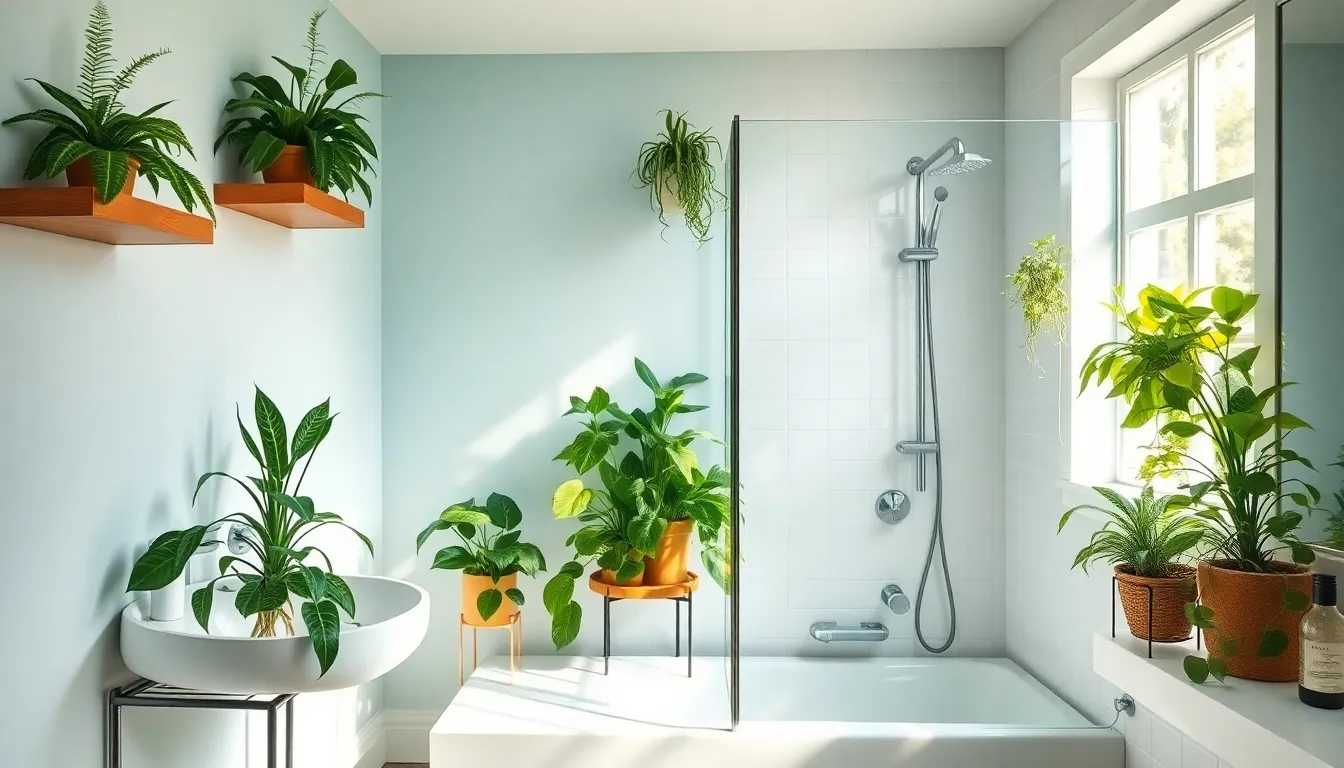
Now that we’ve covered plant selection and basic care, let’s explore innovative ways to showcase your bathroom greenery. These creative display answers maximize space while turning your plants into stunning decorative features.
Floating Shelves and Wall-Mounted Planters
Floating shelves provide an elegant solution for displaying plants without cluttering valuable counter space. We recommend installing them at varying heights to create visual interest while keeping your ferns, pothos, and succulents easily accessible for care. These shelves work particularly well when they receive adequate humidity and natural light from nearby windows.
Wall-mounted planters transform your bathroom walls into living art installations. Vertical wall planters make excellent use of unused wall space and create a lush, sophisticated atmosphere. Trailing plants like pothos cascade beautifully from these mounted displays, while succulents add texture and color variation to your vertical garden setup.
Shower Caddies Converted to Plant Holders
Repurposing shower caddies offers a brilliant way to integrate plants directly into your shower area. Steel shower shelves and built-in niches provide perfect homes for moisture-loving plants like ferns and pothos, which thrive in the humid shower environment. This creative approach keeps plants off your counters while showcasing them in their ideal growing conditions.
Built-in shower niches work exceptionally well for this purpose, blending functionality with modern decorative style. We’ve found that plants placed in these converted spaces flourish due to the consistent humidity levels, creating a spa-like experience during your daily routines.
Tiered Plant Stands for Vertical Gardens
Tiered plant stands maximize floor space while creating stunning mini vertical gardens in your bathroom. These multi-level displays accommodate plants of varying sizes at different heights, ensuring each plant receives optimal light exposure while creating ever-changing visual interest. The cascading effect of trailing plants from different tiers adds incredible lushness to your bathroom space.
Vertical plant arrangements work particularly well in bathrooms with limited floor area, transforming small spaces into green sanctuaries. We recommend mixing plant sizes and types across the tiers to create depth and texture, bringing the feel of an indoor garden into your bathroom without overwhelming the space.
Conclusion
We’ve shown you how easy it is to transform your bathroom into a lush green sanctuary that benefits both your health and well-being. With the right plant choices and proper care techniques you can create a spa-like atmosphere that purifies your air while adding natural beauty to your daily routine.
Remember that success with bathroom plants comes down to understanding your space’s unique conditions and choosing varieties that thrive in humidity and lower light. Whether you’re starting with beginner-friendly options like snake plants or expanding to more exotic orchids the key is matching plants to your bathroom’s environment.
Start small with one or two plants and gradually build your collection as you gain confidence. Your bathroom can become a thriving green oasis that makes every visit feel like a mini retreat.
Frequently Asked Questions
What are the main benefits of adding plants to my bathroom?
Adding plants to your bathroom provides three key benefits: improved air quality and humidity control by absorbing toxins and excess moisture, natural stress relief and calming ambiance that enhances your wellness routine, and enhanced aesthetic appeal by adding visual interest and breaking up monotonous color schemes with strategic placement.
Which plants are best for beginners in low-light bathrooms?
The best beginner-friendly plants for low-light bathrooms are snake plants, pothos, and ZZ plants. These varieties are extremely resilient, require minimal care, and thrive in the humid conditions typical of bathrooms while tolerating low-light environments that many bathrooms provide.
How should I adjust my watering schedule for bathroom plants?
Bathroom plants typically need 25-30% less frequent watering due to the naturally moist environment. Always check soil moisture levels before watering and ensure proper drainage to prevent root rot. The high humidity means plants absorb moisture from the air, reducing their watering needs.
What plants thrive in high-humidity bathroom environments?
Humidity-loving plants that flourish in bathrooms include Boston ferns with their lush fronds, air plants for unique display options, and orchids for elegant blooms. These plants naturally prefer the moist, warm conditions found in most bathrooms and will thrive with minimal additional care.
Where should I place plants in my bathroom for optimal growth?
Strategic placement includes window sills for natural light-loving plants with varying heights for visual interest, hanging plants to maximize vertical space in small bathrooms, and corner displays using floor and elevated plants. Consider placing mirrors behind plant setups to reflect light and create a more spacious feel.
How can I grow plants in a windowless bathroom?
For windowless bathrooms, choose low-light tolerant varieties like snake plants or ZZ plants, and consider installing LED grow lights to support plant health. These artificial lights can supplement the lack of natural light and help your plants photosynthesize effectively in darker spaces.
What are common mistakes to avoid with bathroom plants?
Avoid overwatering due to increased humidity, choosing plants that require too much light for dim spaces, and poor air circulation that can lead to mold and fungal issues. Ensure proper drainage, select appropriate low-light varieties, and maintain adequate spacing between plants for airflow.
What are creative ways to display plants in small bathrooms?
Creative display methods include using floating shelves and wall-mounted planters for vertical space, repurposing shower caddies as plant holders for moisture-loving varieties, and using tiered plant stands to create mini vertical gardens that accommodate plants of varying sizes while maximizing light exposure.


